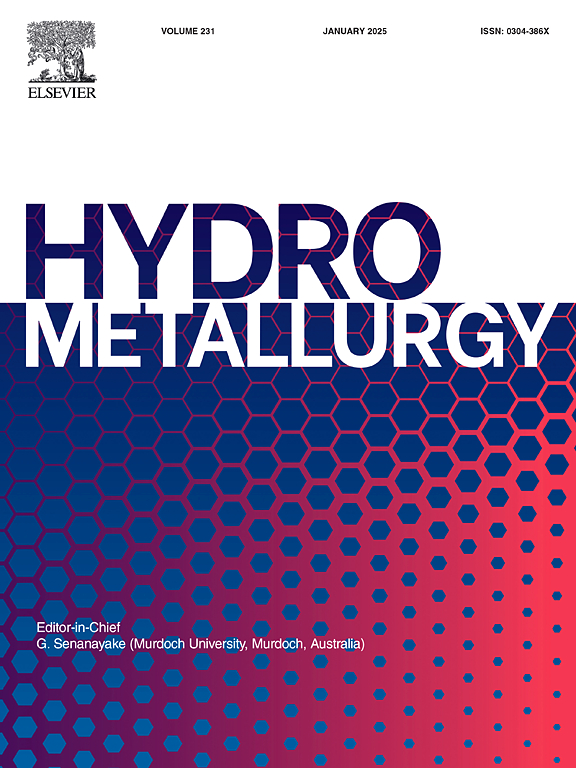Study of hydrogen gas formation during leaching of weakly radioactive ores of the Tomtor deposit: Geo-radiochemical nature of the reducing properties of the ore
IF 4.8
2区 材料科学
Q1 METALLURGY & METALLURGICAL ENGINEERING
引用次数: 0
Abstract
Direct alkaline leaching of weakly radioactive rare metal ores of the Tomtor deposit (Russia) was investigated. It was found that the process of leaching monazite with sodium hydroxide solutions in the presence of various associated mineral components is accompanied by the release of significant amounts of hydrogen and the formation of stable foam filling the reactor and preventing the elimination of hazardous gas. The discovered phenomenon is unique, since hydrogen release occurs at a high rate even at low temperatures (40–50 °C) and when leaching ores in both alkaline and acidic environments (hydrofluoric acid solutions). It is assumed that the high reduction potential of the ores is associated with the deaeration of mineral components (oxygen removal) during their long-term radiochemical irradiation. Preliminary studies using solid-state NMR confirmed this assumption. A significant amount of hydride ions, which are part of stable mixed cluster compounds of aluminum oxides and phosphates, were found in ore samples. It is assumed that the high stability of the foam formed in this process is due to the formation of a structural and mechanical barrier of hydrophobic pulp particles, including un-decomposed pyrite. Undesirable foaming is eliminated by adding an anionic surfactant (sodium stearate) to the pulp, which ensures the removal of hydrophobic particles from the surface of gas bubbles.
托托尔矿床弱放射性矿石浸出过程中氢气形成的研究:矿石还原性的地球放射化学性质
对俄罗斯托托矿床弱放射性稀有金属矿石进行了直接碱浸试验。研究发现,在各种伴合矿物成分存在的情况下,用氢氧化钠溶液浸出独居石的过程伴随着大量氢气的释放,并形成稳定的泡沫填充反应器,阻止了有害气体的消除。所发现的现象是独特的,因为即使在低温(40-50°C)和在碱性和酸性环境(氢氟酸溶液)中浸出矿石时,氢的释放速度也很高。假定矿石的高还原潜力与长期放射化学照射期间矿物成分的脱氧(除氧)有关。使用固态核磁共振进行的初步研究证实了这一假设。在矿石样品中发现了大量的氢化物离子,氢化物离子是氧化铝和磷酸盐稳定混合簇化合物的一部分。假设在此过程中形成的泡沫具有高稳定性是由于疏水纸浆颗粒(包括未分解的黄铁矿)形成了结构和机械屏障。通过在纸浆中添加阴离子表面活性剂(硬脂酸钠)来消除不希望的泡沫,这确保了从气泡表面去除疏水颗粒。
本文章由计算机程序翻译,如有差异,请以英文原文为准。
求助全文
约1分钟内获得全文
求助全文
来源期刊

Hydrometallurgy
工程技术-冶金工程
CiteScore
9.50
自引率
6.40%
发文量
144
审稿时长
3.4 months
期刊介绍:
Hydrometallurgy aims to compile studies on novel processes, process design, chemistry, modelling, control, economics and interfaces between unit operations, and to provide a forum for discussions on case histories and operational difficulties.
Topics covered include: leaching of metal values by chemical reagents or bacterial action at ambient or elevated pressures and temperatures; separation of solids from leach liquors; removal of impurities and recovery of metal values by precipitation, ion exchange, solvent extraction, gaseous reduction, cementation, electro-winning and electro-refining; pre-treatment of ores by roasting or chemical treatments such as halogenation or reduction; recycling of reagents and treatment of effluents.
 求助内容:
求助内容: 应助结果提醒方式:
应助结果提醒方式:


